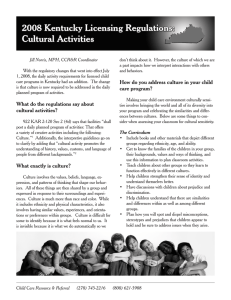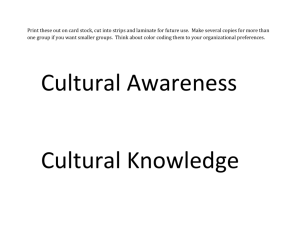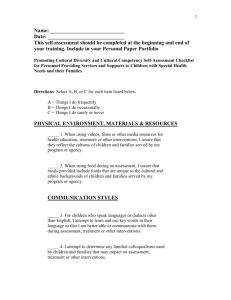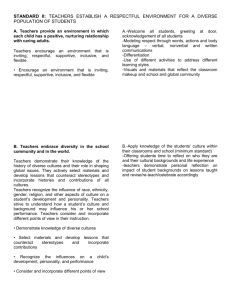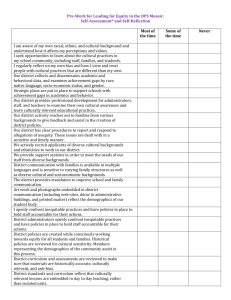Global Learning Tool
advertisement
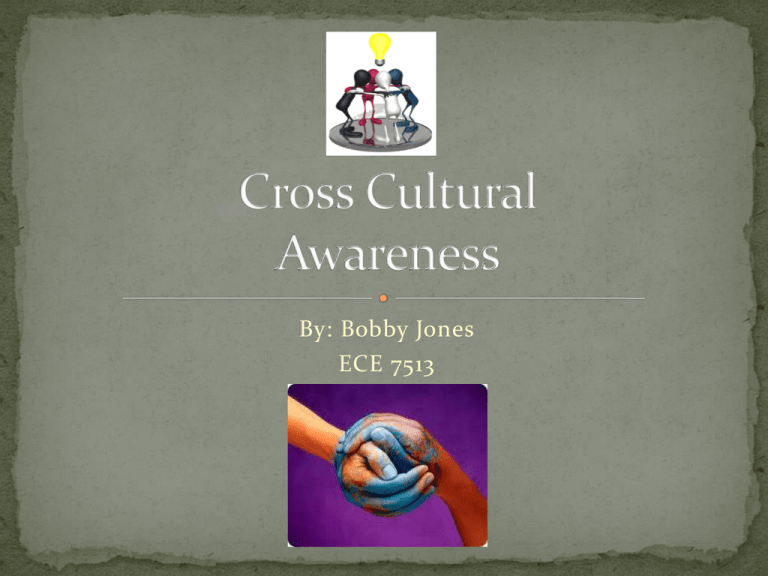
By: Bobby Jones ECE 7513 The capability of standing back from ourselves and becoming aware of our cultural values, beliefs and perceptions. One is understanding of the differences between people from other places around the world and from different backgrounds. Cross cultural awareness can give us better understanding of our own culture and how it is perceived by outsiders. It’s important in creating understanding and acceptance of all individuals. We need to understand other cultural backgrounds to make sense of different view points and opinions. Culture inf luences many parts of peoples lives including: food, dress, opinions, identity, music, buildings, manners, social interaction, and language. Students interact with people of all cultures today. It is important that they are aware of the various ways people see, interpret, and evaluate things in life. A student who is culturally aware will be conscious of the beliefs a culture may see as appropriate, while another culture may view it as inappropriate. Students who are not culturally aware of these differences can only generate misunderstandings. Without cross cultural awareness, students will generate stereotypes from the misconceptions they develop. Students who are not conscious of the differences in behavioral rules of different cultures may develop false assumptions about people. Students will generate these ideas as a given culture as being “disabled”. Students will treat them differently due to the power of their own cultural beliefs. Students who are not cross culturally aware will miss out on the various opportunities to immerse themselves in other perceptions of the world. Students will be blind to the differences that make us unique and original in identity. A student who is not conscious of cultural boundaries may offend or judge an individual due to the lack of cross cultural awareness. It is difficult to help students become aware of cross cultural awareness because they may not be alert of how it guides our thinking. Culture is something a person is born into and they never stop to question the way they were taught to act and view things. It can be very difficult to accept different ways of thinking and appropriate behavior because of trained beliefs. Students may be aware of the cultural differences people possess, but the challenge is being to be aware of the different levels of cross cultural awareness. Four Levels of Cross Cultural Awareness: Parochial Stage 2. Ethnocentric Stage 3. Synergistic Stage 4. Participatory Stage 1. 1. Parochial Stage This stage is the first stage where students have this perception that their way is the only way. They fail to realize the inf luence of cultural differences. 2. Ethnocentric Stage This second stage of cross cultural awareness has the student conscious of cultural differences, but believes their culture is superior. The student tend to view cultural differences as problems and will disregard them due to the lack of importance. 3. Synergistic Stage The student believes that there are two separate ways. They are compared to determine in which situations one is viewed as the correct way. Students will use cultural diversity to develop new explanations and options. 4. Participatory Stage Students in this stage view cross cultural awareness as our way. The individual includes different cultural backgrounds to develop a culture of shared meanings. The students is able to generate new ways and understandings in a given circumstance. Stand Alone Units/Integration: -Reading comprehension: Literature from various cultures -Historical figures from various cultural backgrounds -Get to know you activities to introduce culture identity -Incorporating Maps into lessons/activities -Information writing: Informing the audience of various cultural differences -Various teaching methods to allow for different learning styles adopted in various cultures -Illustrations in non -fiction texts -Hands -on Manipulatives and artifacts from other countries -Current events to better grasp concepts of cultural differences -Thematic Units on a given country -Vocabulary Enrichment of various languages -Respectful Activities to ensure cross cultural awareness -Flexible grouping to allow students to work with a variety of peers -Quality Curriculum: Making it relevant to all students’ lives -Learning environment representing the whole student population -Child Centered: connected to many cultures present -Incorporate multicultural information resources/materials in all subjects routinely -Oral presentations on students’ native countries -Autobiographical writing assignments -Give praise on students’ cultural heritage -Cultural celebrations/holiday recognition - Study abroad programs There have been Cultural Awareness Programs provided to cover a broad number of cultural issues relevant to cross -cultural interaction, so as to enable individual participants to better understand, engage with and offer services to individuals, families, and communities. Cultural Awareness Programs (CAP) Committee Responsibilities: Help to create an environment in which cultural awareness leads to the understanding and valuing of diversity with schools. Collaborate with campus, local, and regional groups to plan, fund, and produce educational events and programs to meet identified needs. Seek funding for the CAP programs and produce annual report of program outcomes. Gopal, A. (2011). Internationalization of Higher Education: Preparing Faculty to Teach Cross-Culturally. International Journal Of Teaching And Learning In Higher Education, 23(3), 373-381. Koo Moon, H., Kwon Choi, B., & Shik Jung, J. (2012). Previous international experience, cross-cultural training, and expatriates' cross -cultural adjustment: Effects of cultural intelligence and goal orientation. Human Resource Development Quarterly, 23(3), 285-330. Schlein, C., & Garii, B. (2011). Cross-Cultural Interpretations of Curricular Contextual Crossings. Issues In Teacher Education, 20(2), 81-94.


